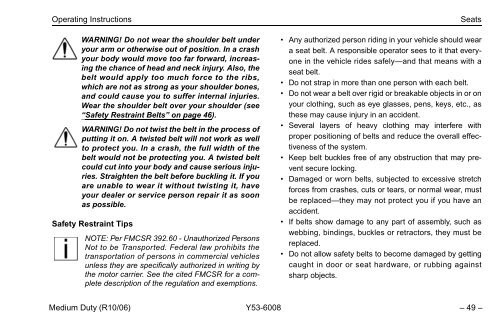Peterbilt Medium Duty Trucks Operator's Manual after 1-07
Peterbilt Medium Duty Trucks Operator's Manual after 1-07
Peterbilt Medium Duty Trucks Operator's Manual after 1-07
You also want an ePaper? Increase the reach of your titles
YUMPU automatically turns print PDFs into web optimized ePapers that Google loves.
Operating Instructions<br />
WARNING! Do not wear the shoulder belt under<br />
your arm or otherwise out of position. In a crash<br />
your body would move too far forward, increasing<br />
the chance of head and neck injury. Also, the<br />
belt would apply too much force to the ribs,<br />
which are not as strong as your shoulder bones,<br />
and could cause you to suffer internal injuries.<br />
Wear the shoulder belt over your shoulder (see<br />
“Safety Restraint Belts” on page 46).<br />
WARNING! Do not twist the belt in the process of<br />
putting it on. A twisted belt will not work as well<br />
to protect you. In a crash, the full width of the<br />
belt would not be protecting you. A twisted belt<br />
could cut into your body and cause serious injuries.<br />
Straighten the belt before buckling it. If you<br />
are unable to wear it without twisting it, have<br />
your dealer or service person repair it as soon<br />
as possible.<br />
Safety Restraint Tips<br />
NOTE: Per FMCSR 392.60 - Unauthorized Persons<br />
Not to be Transported. Federal law prohibits the<br />
transportation of persons in commercial vehicles<br />
unless they are specifically authorized in writing by<br />
the motor carrier. See the cited FMCSR for a complete<br />
description of the regulation and exemptions.<br />
Seats<br />
• Any authorized person riding in your vehicle should wear<br />
a seat belt. A responsible operator sees to it that everyone<br />
in the vehicle rides safely—and that means with a<br />
seat belt.<br />
• Do not strap in more than one person with each belt.<br />
• Do not wear a belt over rigid or breakable objects in or on<br />
your clothing, such as eye glasses, pens, keys, etc., as<br />
these may cause injury in an accident.<br />
• Several layers of heavy clothing may interfere with<br />
proper positioning of belts and reduce the overall effectiveness<br />
of the system.<br />
• Keep belt buckles free of any obstruction that may prevent<br />
secure locking.<br />
• Damaged or worn belts, subjected to excessive stretch<br />
forces from crashes, cuts or tears, or normal wear, must<br />
be replaced—they may not protect you if you have an<br />
accident.<br />
• If belts show damage to any part of assembly, such as<br />
webbing, bindings, buckles or retractors, they must be<br />
replaced.<br />
• Do not allow safety belts to become damaged by getting<br />
caught in door or seat hardware, or rubbing against<br />
sharp objects.<br />
<strong>Medium</strong> <strong>Duty</strong> (R10/06) Y53-6008 – 49 –
















